Monsoon Update: Zen & the Jazz of Green Building in India
The biggest news on the construction of the Dharmalaya Institute is in regard to our race against time to get the roof on our baby building before the onslaught of the monsoon rains this month… and the update is that, well, we couldn’t win, so we’ve done our best to change the game.
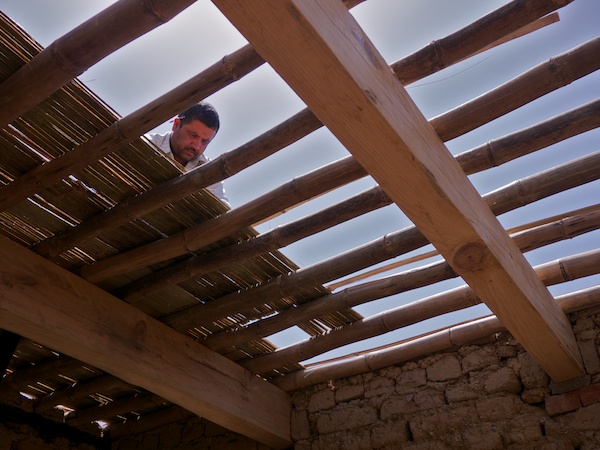
Laying the bamboo roof
To understand the snag, one must first have an idea of the way traditional roofs are built here in the Kangra Valley. Local roofs are gable roofs made of slate shingles fastened to a truss of wooden struts supported by bamboo rafters. The strength of the roof relies primarily upon the bamboo, and the strength of the bamboo, in turn, depends upon not only size and age of the bamboo but also the time of year when it is harvested.
For maximum durability, the bamboo must be cut during the new moon of late December or early January. If that sounds like hocus pocus, then consider that this is the time of year when the plant is most dormant and thus its sugar content is lowest. If bamboo is cut at other times of year, the more plentiful sugars harden as starches, a delicacy for termites and other critters. When feasted upon, such bamboo loses much of its strength and no longer can be counted upon to do its job holding the building up (and so must be replaced, generally within 10-15 years). When bamboo is cut at its most dormant moment, however, it contains very little that is appetizing to insects and thus the structural integrity and strength of the bamboo remains intact for decades (and, in some cases, such as when it is thoroughly smoked, it can last for centuries).
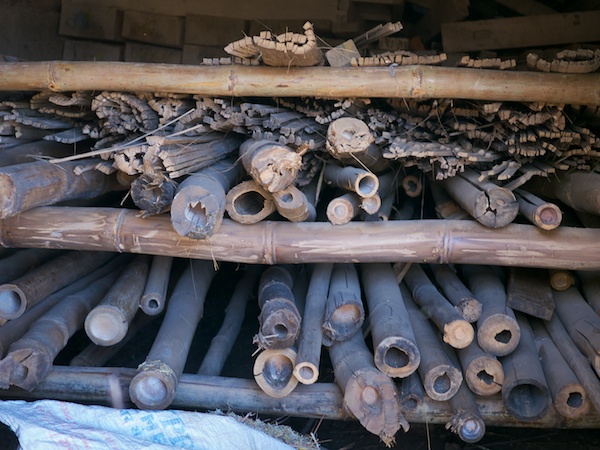
Bamboo kiln
Bamboozled
Accordingly, during the new moons of December and January, we organized a couple of big bamboo harvesting expeditions.

Harvesting bamboo
Turns out they weren’t big enough, though: we wound up with less than half of the bamboo required to complete the building. If you’re thinking, “oops,” then you got the picture.
How could such a miscalculation happen? Well, turns out there are different ways to count bamboo around here: some people count one pole as one pole, while others count one pole as two or three poles (depending on the sizes into which it will be cut). Our local crew who did the cutting were not familiar with the counting method used by the people who told us how many to cut, so a request for 180 was taken as 180 cut poles, when what was actually intended was 180 uncut poles (which would translate into as many as 360 or even 540 cut poles, depending on the lengths of the cuttings). By the time any of us caught the error, it was May — far too late to harvest any additional bamboo — and suddenly we realized that there was simply no way that we would be able to build the roof this year.
What to do? We had just completed the construction of the walls of the ground floor level, but had not yet begun raising the upstairs walls. Better to leave it that way, all agreed, for the simple reason that a shorter wall is easier to protect from the elements than a taller one. So, knowing now that our construction would be halted till autumn, our attention turned completely to the pressing puzzle at hand: how could we protect our half-finished mud-brick building from the assault of the impending monsoon rains without a proper roof — and fast?
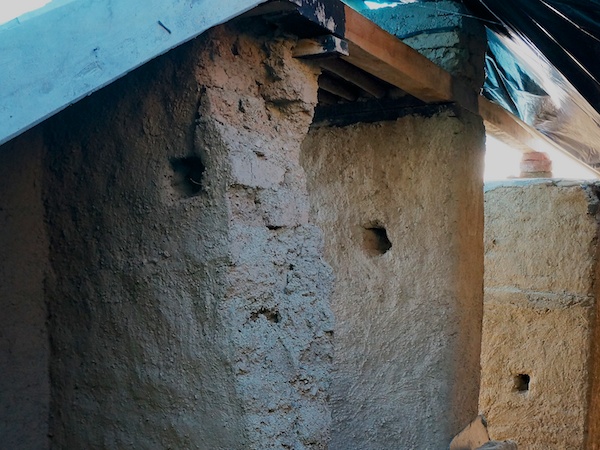
Rain damage
Shelter Seeks Same
Studying the rain and wind patterns during the pre-monsoon showers of May, and the way they affected our vulnerable adobe walls, we saw that the north face of the building was hardest hit and thus most in need of protection, while other areas had different needs and the various shapes and sizes of spaces begged for different solutions. So, our eco-architect, mentor, and friend, Didi Contractor, walked us through the creation of a patchwork plan to give each part of the building what it needed while ensuring that drainage from each section would be channeled in such as a way as not to create trouble in a neighboring section.
First, we prepped what little useable, smoked bamboo we had at the ready to build a ceiling over the office and adjacent hallway, topped with a thin layer of ferrocrete that will serve as the base of the floor for the room upstairs — and, meanwhile, will help keep the water out, allowing us to use the office and hallway for storage of our stockpile of unused mud bricks through the monsoon.
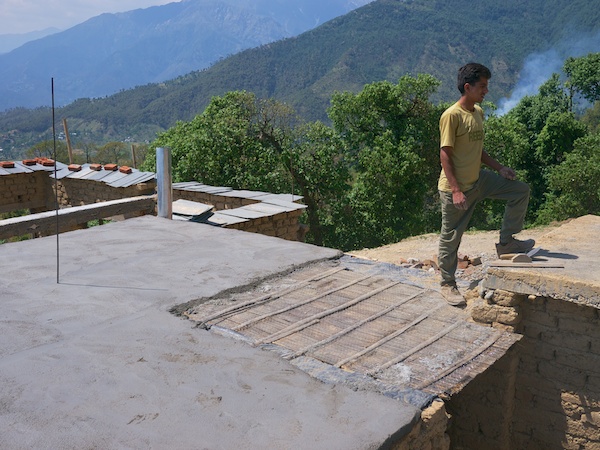
Ferrocrete stage
Next, we built a temporary framework of (unseasonal) bamboo to support an ad-hoc roof of plastic tarps over the bedrooms. Then, a system of drainage ditches encircling the building to channel the torrents away from the walls and safely distribute the water across the hillside.
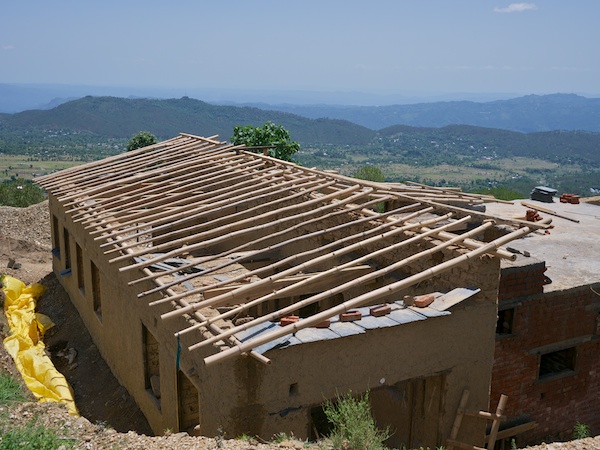
Bamboo truss
Not Just for Breakfast Anymore
One of the most important protective measures we took was to render the walls of the building with a plaster made of mud mixed with the husk and chaff of flax (yes, flax — the same plant that produces the seeds that are added to some supposedly salubrious cereals for marketing purposes but actually don’t do a bit of good for the health when the seeds are eaten whole because they’re too small to be broken up by the teeth so they pass right through the body and come out looking just the way they did in the cereal box). It’s well known in the green building world that flax seed oil (a.k.a. linseed oil), in addition to being (genuinely) beneficial for the body, is also an effective water repellant and sealant for walls and floors, but we learned that the chaff (the husk of the flax seeds and the straw of the surrounding plant) is also useful as a waterproofing agent when generously mixed into the mud plaster.
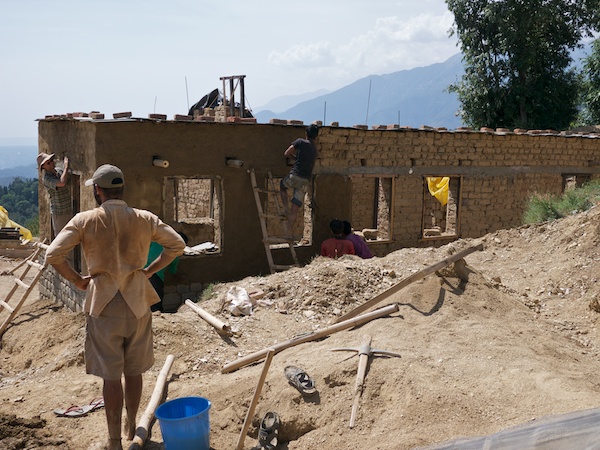
Mud and flax render
As soon as we completed an initial render on the critical north wall, Mama Nature gave us a chance to test-drive the flax plaster, in the form of a couple of thunderstorms that rocked the valley and pelted the newly flaxed-up walls of our building. The results were strikingly impressive: while areas of wall lacking the flax chaff were visibly eroded by just a few hours of strong rain, the walls with the mud-and-flax render were almost completely unchanged. Eureka!
Seeing what a difference the flax chaff makes, we went on to render all the exterior and interior walls of the building for good measure. Practitioner’s note: applying a fine mud plaster by hand is an epicurean joy, but can trigger cravings if one can’t escape the associations with chocolate frosting. 😉
Wrapping It Up
For double protection, we strung a collection of tarps across the bamboo frameworks and draped a few more over the vulnerable northern walls, and then carefully laid slate tiles all along the tops of the walls to serve as a first defense against the most direct path of the rain.
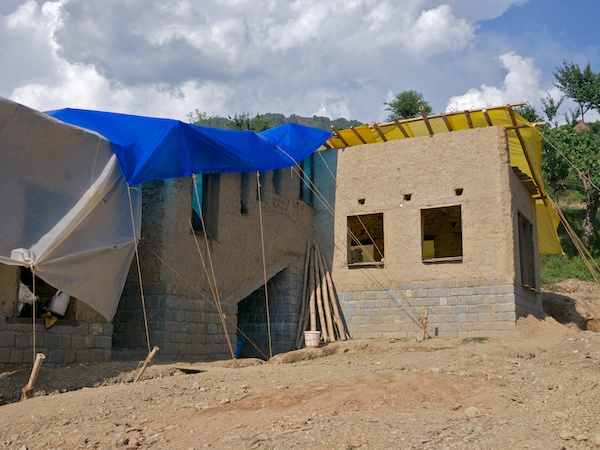
A raincoat of tarpaulins
Altogether, it seems we now have the best possible solution, given the circumstances. We’ll have a skeleton crew working through the monsoon season (mostly planting trees), so of course they’ll be monitoring the building as well as the landslide and the new drainage systems. And, as our local friends say, “rest is stars.”

All wrapped up
We plan to resume construction work in sunny November. We’re planning at least two or three intensive service-learning retreats for autumn 2011 and spring 2012. And, of course, you’re all welcome to join in the fun or support from afar.
Get Involved
Here are a few ways you can participate:
- VOLUNTEER: Come to Bir (in northern India) in late 2011 or spring 2012 to volunteer. › details
- DONATE: Make a charitable donation to support our eco-construction and the green jobs it creates (tax-deductible in the US and India). › details
- SPONSOR TREES: Offset your carbon emissions for the year, while creating more green jobs, by sponsoring tree plantings in the Earthville Orchards. › details
- SPREAD THE WORD: Forward this story to your friends, post it on your blog, share this story on Facebook and “like” the Earthville and Dharmalaya FB pages, send forth a mighty tweet, or, you know, talk to people. 🙂
For more information about the Dharmalaya Institute and how you can get involved, see the Dharmalaya website.

I’m surprised an almost entirely wooden roof can withstand a monsoon. Looks like a great project.
Thank you for this wonderful post. Found it really useful. We also have a bamboo rafter, bamboo mat, thin concrete roof and were surprised to learn how rain-proof this roof can be. Of course, downpours here are nothing compared to the manna there but it shows the feasibility of bamboo against rain.